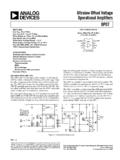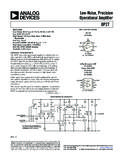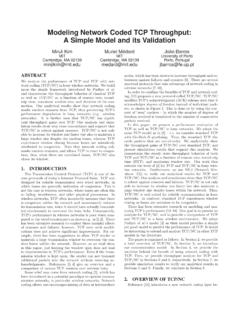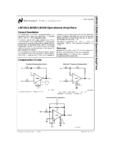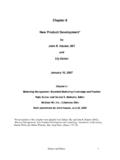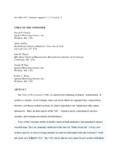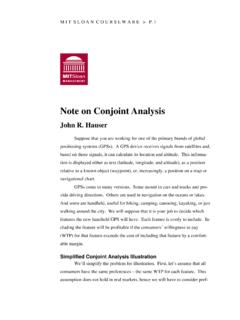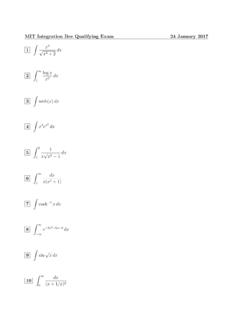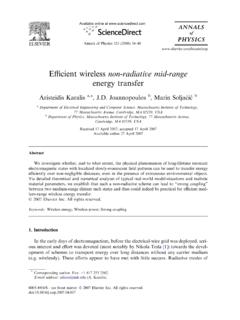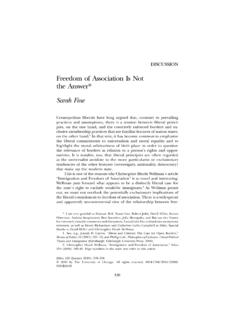Transcription of Analog-to-Digital Converter Testing
1 analog -to-DigitalConverterTestingKent essential buildingblocks in criticallinkbetween front-endanalogtransducersandback-enddig italcomputersthatcan e ciently implement a widevariety of of digital-signal-processingapplicationslea dsto the availability of a widevariety of Analog-to-Digital (A/D)convertersof varyingprice,performance,and , an A/Dconverterencodes a continuous-timeanaloginputvoltage,VIN, into a seriesofdiscreteN-bit digitalwordsthatsatisfythe relationVIN=VFSN 1Xk=0bk2k+1+ whereVFSis the full-scalevoltage,bkare the individualoutputbits,and is the alsobe writtenin termsof the leastsigni cant bit (LSB)or quantumvoltagelevelVQ=VFS2N= 1 LSBasVIN=VQN 1Xk=0bk2k+ A plotof this idealcharacteristicfor a 3-bitA/Dconverteris shown in OutputAnalog Input1/801/43/81/25/83/47/8 FScentercode= 1 LSBcode widthFigure1: uniquedigitalcode correspondsto a smallrangeof LSBwide(the\code width")and is centeredaroundthe \code center.
2 "All inputvoltagesresolveto the digitalcode of the nearestcode center. Thedi erencebetween the analoginputvoltageandthe correspondingvoltageof the nearestcode center (thedi erencebetween the solidand dashedlinesin Figure1) is the A/Dconverterhas a nitenumber of outputbits,even an idealA/Dconverterproducessomequantizatio nerrorwithevery A/DConverterFiguresof MeritThenumber of outputbitsfroman analog -to-digitalconverterdo not fullyspecifyits di erfromidealbehaviorin many ,such as gainando set,are easyto quantify, the successof many signal-processingapplicationsdependson the dynamicbehaviorof the , the applicationdeterminesthe requirements, and A/Dconverterresolutionmay not be eithernecessaryor su cient to specifythe many cases,the quality of the A/Dconvertermust be testedfor thespeci of analog -to-digitalconverterapplicationsle adsto a largenumber of guresof meritfor guresof meritincludeaccuracy, resolution,dynamicrange,o set,gain,di erential nonlinearity, integralnonlinearity, signal-to-noiseratio,signal-to-noise-and -distortionratio,e ective number of bits.
3 Spurious-freedynamicrange,intermodulatio ndistortion,totalharmonicdistortion,e ective resolutionbandwidth,full-power bandwidth,full-linearbandwidth,apertured elay, aperturejitter,transient response,and cationscan be looselydividedinto threecategories| staticparameters,frequency-domaindynamic parameters,andtime-domaindynamicparamete rs| andare de nedin the A/Dconverterspeci cationsthatcan be testedat low speed,or evenwithconstant cationsincludeaccuracy, resolution,dynamicrange,o set,gain,di erential nonlinearity, and the totalerrorwithwhich the A/Dconvertercan convert a known voltage,includingthe e ectsof quantizationerror,gainerror,o seterror,and , accuracyshouldbe traceableto known standards(for example,NIST),and is generallya \catch-all"termfor all the number of bits,N, out of the Figure1shows a 3- mostnoticeablespeci cation,resolutiondeterminesthesize of the leastsigni cant bit, and thus determinesthe dynamicrange,the code widths,and the ratioof the smallestpossibleoutput(theleastsigni cant bit or quantumvoltage)to the largestpossibleoutput(full-scalevoltage) ,mathematically20 log102N setErrorO seterroris the deviationin the A/Dconverter'sbehaviorat rsttransitionvoltageshouldbe 1=2 LSBabove seterroris the deviationof the actualtransitionvoltagefromthe ideal1=2 seterroris easilytrimmedby locationof the rsttransitionsin Figures1 and OutputAnalog Input01/81/43/81/25/83/47/8 FSFigure2.
4 analog -to-digitalconvertercharacteristic ,showingo setand the deviationin the slope of the line throughthe A/Dconverter'send points at zeroand full scalefromthe idealslope of 2N=VFScodes-per-volt. Like o seterror,gainerroris easilycorrectedby slope of the dashedlinesin Figures1 and OutputAnalog Inputmaximum1/81/43/81/25/83/47/8 FSnarrow code widthsnegative DNLwide code widthspositive DNLmissing codeINL = 1 LSBF igure3: analog -to-digitalconvertercharacteristic ,showingnonlinearity errorsand a is the idealcharacteristic,and the dottedline is the best erential NonlinearityDi erential nonlinearity (DNL)is the deviationof the code transitionwidthsfromthe idealwidthof 1 code widthsin the idealA/Dconverterare 1 LSBwide,so the DNLwouldbe onlythe \maximum DNL."See the widerangeof code widthsillustratedin (INL)is the distanceof the code centers in the A/Dconvertercharacteristicfromthe all code centerslandon the idealline,the INLis onlythe \maximum INL.
5 "See the deviationsof the code centers fromthe ideallinein two possibleways to expressmaximum INL,dependingon your de nitionof the \idealline."DatasheetINLnumbers can be decreasedby quotingmaximum INLfroma\best t" lineinsteadof the Figure3, the idealline(shown dashed)exhibitsanINLof 1 LSB,whilethe best- tline (shown dotted)exhibitsan INLof half e ectof INLon totalaccuracy, it is probablya betterre ectionof the A/Dconverter'slinearity in are outputdigitalcodes thatare not producedfor any inputvoltage,usuallydue someconverters,missingcodes can be causedby non-monotonicity of the Figure3 causescode 100 to be \crowdedout." QuantizationNoiseQuantizationerrordue to the niteresolutionNof the A/Dconverterlimitsthe in an idealA/Dconverter,the quantizationof the inputsignalcreateserrorsthatbehave like inputswithin 1=2 LSBof a code center resolve to thatdigitalcode.
6 Thus,therewill be a smalldi erencebetween the code center and the actualinputvoltagedue to assumethatthis errorvoltageis uncorrelatedand distributeduniformly, we cancalculatethe expectedrms valueof this \quantizationnoise."11111010110001101000 1000 Digital OutputAnalog Input1/801/43/81/25/83/47/8 FScentercode= 1 LSBcode width01/81/43/81/25/83/47/8 FSAnalog InputError VoltageError = Output InputFigure4: Quantizationerrorvoltagefor to quantizationcan be the error5voltageis the quantumvoltagelevel (theleastsigni cant bit)VQ=VFS2N= 1 LSBF initeamplituderesolutionintroducesa quantizationerrorbetween the analoginputvoltageandthe quantizationerrorvoltageis uniformlydistributedover the code widthfrom 1=2 LSBto +1=2 LSB,the expectationvalueof the errorvoltageisEf 2g=1 VQZ+12VQ 12VQ 2d =1VQ" 33#+12VQ 12VQ=V2Q12 Thisquantizationnoiseis assumedto be ,themaximum signal-to-noiseratiofor a full-scaleinputcan be valueof a full-scalepeak-to-peak amplitudeVFisVrms=VFS2p2=2 NVQ2p2thus the signal-to-noiseratioisSNR= 20 log VrmspE( 2)!
7 = 20 log(2Np1:5) = 6:02N+ 1:76 dBwhenthe noiseis due onlyto result,we can tabulatethe idealsignal-to-noiseratiofor several A/Dconverterresolutionsin : Idealsignal-to-noiseratiodue to shows the fast Fouriertransform(FFT)spectrumof a sinewave sampledby an ideal10- oor in this gureis dueonlyto anM-point FFT,the averagevalueof the noisecontainedin each frequencybin is 10 log2(M=2) dBbelow the rmsvalueof the \FFTprocessgain"is why the noise oorappears30 dB lower thanthe quantizationnoiselevel listedin realanalog-to-digitalconvertershave additionalnoisesourcesanddistortionproce ssesthatdegradethe performanceof the A/Dconverterfromthe the dynamicbehaviorof the A/Dconverterare quanti edand reportedina variety of amplitudeFFT frequency binFigure6: Quantizationnoise oor for an ideal10-bitA/Dconverter(4096point FFT). (S/N+D,SINAD,or SNDR)is the ratioof the inputsignalamplitudeto the rms sumof all otherspectralcomponents.
8 For anM-point FFTof a sinewavetest,if the fundamental is in frequencybinm(withamplitudeAm), the SNDRcan be calculatedfromthe FFTamplitudesSNDR= 10 log264A2m0@m 1Xk=1A2k+M=2Xk=m+1A2k1A 1375To avoid any spectralleakage aroundthe fundamental, oftenseveral binsaroundthe fundamentalare dependent on the input-signalfrequencyand amplitude,degradingathighfrequencyand power. Measuredresultsare oftenpresented in plotsof SNDR versusfrequencyfor a constant-amplitudeinput,or SNDR versusamplitudefor a ective Number of BitsE ective number of bits (ENOB)is simplythe signal-to-noise-and-distortionratioexpre ssedin bitsratherthandecibels by solvingthe \idealSNR"equationSNR= 6:02N+ 1:76 dBfor the number of bitsN, usingthe measuredSNDRENOB=SNDR 1:76 dB6:02 dB=bitIn the presentationof measuredresults,ENOBis identicalto SNDR,witha changein the scalingof the DynamicRangeSpurious-freedynamicrange(SF DR)is the ratioof the inputsignalto the peak spuriousor peakharmoniccomponent.
9 Spurscan be createdat harmonicsof the inputfrequencydue to nonlineari-ties in the A/Dconverter,or at subharmonicsof the samplingfrequencydue to mismatch or clock7couplingin the SFDRof an A/Dconvertercan be largerthanthe SFDRcan be facilitatedby increasingthe number of FFTpoints or by averagingseveral both cases,the noise oor will improve, whilethe amplitudeof the spurswill stay an A/Dconverterwithsigni cant harmonicspursis shown in Figure7. BecauseSFDRis oftenslew-ratedependent, it will be a functionof inputfrequencyand magnitude[1]. Themaximum SFDR oftenoccursat an amplitudebelow full amplitudeFFT frequency binFigure7: A/Dconverterwithsigni cant nonlinearity, showingpoor the inputsignalare aliaseddown to frequenciesbelow the HarmonicDistortionTotal harmonicdistortion(THD)is the ratioof the rms sumof the rst ve harmoniccomponents(or theiraliasedversions,as in Figure7) to the inputsignalTHD= 10 log V22+V23+V24+V25+V26V21!
10 WhereV1is the amplitudeof the fundamental, andVnis the amplitudeof then-th (IMD)is the ratioof the amplitudesof the sumand di erencefrequenciesto the inputsignalsfor a two-tonetest,sometimesexpressedas \intermod-freedynamicrange(IFDR)"See the FFTspectrumin Figure8. For second-orderdistortion,the IMDwouldbeIMD= 10 log V2++V2 V21+V22!whereV1andV2are the rms amplitudesof the inputsignals,andV+andV are the rms amplitudesof the sumand di ective ResolutionBandwidthE ective resolutionbandwidth(ERBW)is the input-signalfrequencywherethe SNDRof the A/Dconverterhas fallenby 3 dB ( ) fromits valuefor amplitudeFFT frequency binFigure8: Two-toneIMDtest withsecond-ordernonlinearity, showing(fromleft)F2 F1product,F1input,F2input,2F1product,F1+ F2product,and BandwidthIn ampli ers,full-power bandwidth(FPBW)is the maximum frequencyat which the ampli ercan reproducea full-scalesinusoidaloutputwithoutdistort ion(sometimescalculatedas slew-ratedividedby 2 Vmax), or wherethe amplitudeof full-scalesinusoidis reducedby 3 dB.
